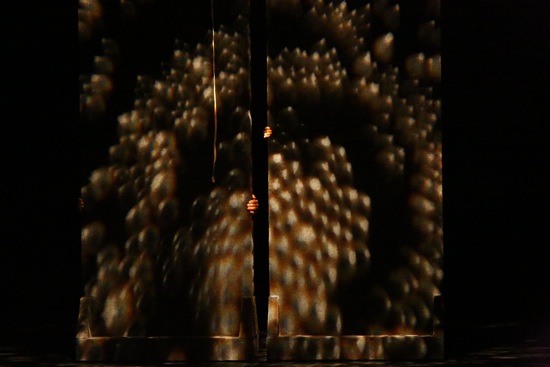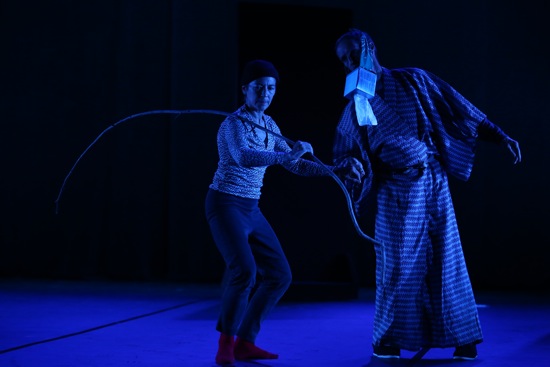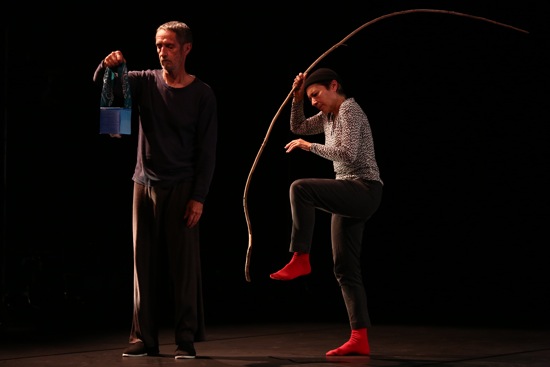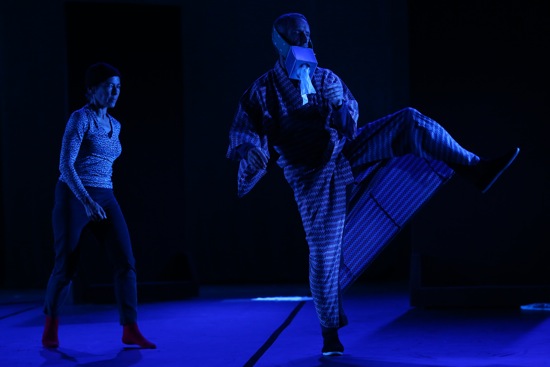Two stellar improvisers, Steve Paxton and Lisa Nelson, recreate a 2004 work at Dia: Chelsea, October 10-12, 17-19.

Is that Steve Paxton’s hand? The image that opens Paxton and Lisa Nelson’s Night Stand. Photo: Paula Court
Steve Paxton and Lisa Nelson came to improvisation from different directions. She was a member of Daniel Nagrin’s Workgroup in the 1970s, the same decade during which Paxton developed contact improvisation. While he was investigating the dynamics of body against body, she was part of a group developing and performing structured improvisations that had, as I recall, psychological implications. In the ensuing decades, she became deeply involved in the body and its subtle responses to change. Seeing these two seasoned improvisers re-create their 2004 Night Stand at Dia: Chelsea is a reminder that one of the pleasures of watching high-level improvised performances is the sense you get of on-the-spot decisions, of accidents that become baby epics, of tides that turn unexpectedly.
Paxton also performed in the 1970s with the wily band of talking-dancing improvisers that called itself the Grand Union. These all-star improvisers—Trisha Brown, Barbara Dilley, Douglas Dunn, David Gordon, Nancy Lewis, Paxton, and (in the beginning, Yvonne Rainer) didn’t plan anything. They arrived at a site—armed perhaps with a bunch of clothes and/or an LP or a reel-to-reel tape of music that they might use, an article they’d read, an adventure they’d had. I still have happy memories of one early Grand Union performance, in which Paxton took it on himself to crawl through a long, fairly narrow tube of pink fabric that had been brought to the show. For quite a long time, he struggled along, giving the impression of a rat being digested by a snake. Occasionally, one of his colleagues would stop whatever he or she was doing squat down and ask him if he was okay. When he finally emerged damply from the end of the tube, he was stark naked, having divested himself along the way of whatever he’d been wearing to begin with.
I mention this because Night Stand has an ambiance that stirs memories of Grand-Union. Paxton and Nelson don’t talk during their improv; any talk comes from a recorded sound compilation that the two of them made. But, as in a Grand Union performance, props and costume elements play an integral role in shaping the event. And these two performers and longtime partners in life—whether wittily, mysteriously, or poignantly—use external elements to trigger or enhance movement. Night Stand employs two panels on wheels; a large platform ditto; a cushion, two long, slim branches, stripped of bark; a plastic bag; a pail; and fabric.
Nelson and Paxton make quite a pair. She has a bit of the pixie hidden in her mature, calm demeanor, and a bit of the shaman. He, now in his mid-seventies, is naturally not the athlete he was when he performed his unforgettable evening-long improvisations to J.S. Bach’s Goldberg Variations (as played by Glenn Gould in two widely-distanced recordings). Lean, weather-beaten and only a bit stiffer, he, like Nelson, is infinitely absorbing to watch.
They begin with a theatrical tease. Their hands appear around the edges of the two panels that are set closely together; the hands grip here, there, disappear, re-appear. The panels, bearing projections that look a little like evergreens, move forward toward the spectators, then retreat. Only then do the houselights begin to dim. A blackout qualifies this sequence as an overture.
When lighting designer Carol Mullins reveals the performers, as she will do in various intriguing ways over the course of Night Stand, Nelson, wearing a mottles top, stretchy pants, and a close-fitting cap is wielding the two branches, making little, clipped moves. Paxton, in a dark, loose-fitting shirt and pants, has staked out the pillow. A high sound is heard, with little things jostling within it (Paxton and Nelson created the “sound compilation,” which includes excerpts from three pieces by Robert Ashley and one by Pyotr Mamonov). Nelson manipulates the branches as if she’s trying to decide what to do with them or how they fit together best. Paxton, at first using mostly his arms, moves as if his body were a new suit of clothes that he didn’t like much (not enough room here, too loose there, scratchy to boot). When Nelson staggers on tiptoe, he watches her.
They’re always aware of each other, whether they touch or not. But much of the time, they concentrate on private tasks, thoughts, feelings. The sound score doesn’t stick to consistency either. At one point, we may hear soft chords and a saxophone (maybe) and whistles. At another, voices only intermittently intelligible. A baby cries (and/or someone imitating a baby cries). One voice mentions a “shitty apartment;” another asks “Qu’est-ce que tu cache?” And, indeed, a lot is hidden, one way or another, including motives. The activities are enigmatic, and some are startling. On the night I attend, while Nelson rests and shakes out her legs, Paxton dons a headpiece that turns out to be a square, “boutique” box of facial tissues attached to a headband.
They experiment with their well-tuned bodies. Paxton, for instance, embarks on a walk with swaying hips. When he puts a cloth over his head and sits there, she walks—now in a squat, now erect. And they do stuff with the stuff. Over time, one of the sticks, stuck in something and attached to the platform, becomes a mast with a blue cloth for a sail (or maybe a flagpole).
Perhaps the reason that Paxton’s 1970s crawl through the pink fabric birth canal came to mind when I started to write this, is that in Night Stand, he and Nelson do a lot of covering things with other things and then uncovering them. Rather than making a drama out of undressing, Paxton pulls off a near-magic trick to do with dressing that makes me think of Kabuki dramas and the “invisible” black-clad stagehands who facilitate onstage costume changes. After he has been under the fabric for a while, he unveils himself, makes a quick move or two, and—shazam!—the cloth turns into a kimono. He, of course, remains grave and focused. Nelson, happening by, adjusts the box on his head so that it sits on his brow, then pulls a tissue to stick out of it. Some samurai.

Lisa Nelson and Steve Paxton travel together, well-equipped, in their Night Stand. Photo: Paula Court
The two of them walk, dance together minimally in ballroom-dance position, sit companionably side by side. Alone or together, they re-arrange the “furniture,” do things with the bucket (it turns out, surprisingly, to be luminous). Filled with air, the plastic bag auditions for the role of Nelson’s headdress. When Paxton handles the two branches, they look like a dancer.
As a title, Night Stand evokes several meanings: one-night stand (which this certainly is not) and the small bedside table that holds the book we are reading and those we plan to read. Also a lamp, maybe a phone. Too, the title conjures up night itself, where many things look different. The imaginatively structured improvisation is a collage of images and actions that might have been drawn from dreams and memories, and that join together oddly as events in dreams have a way of doing. Paxton and Nelson’s matter-of-fact investigation also makes me think of life as a serious playground, where we test things to see how they work, copy those who look as if they know things we don’t, and (maybe) clean up after ourselves before going to bed.



Deborah, it was such a pleasure to read your review of Steve and Lisa. I love the way you describe things and that you, like the dance, evoke such open ended associations.
thank you yet again for your words.
Polly